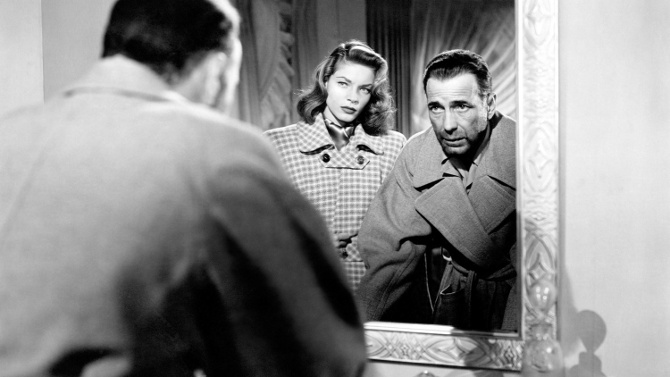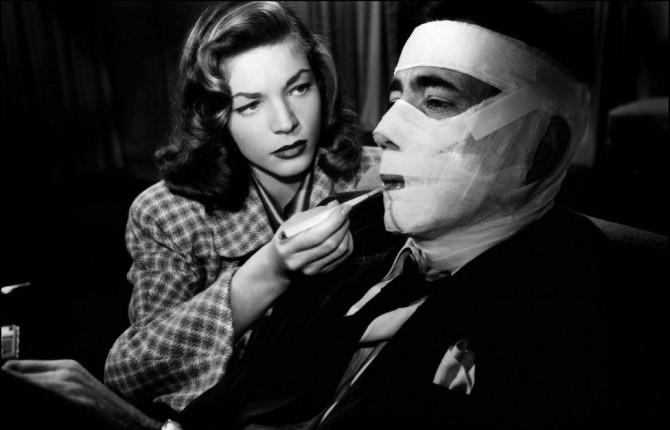Vincent Parry: “You know, it’s wonderful when guys like you lose out. Makes guys like me think maybe we got a chance in this world.”
The third of four films made by the husband and wife dream team of Humphrey Bogart and Lauren Bacall, 1947’s Dark Passage, written and directed by Delmer Daves (Destination Tokyo), is perhaps one of the most unique film noirs of the classical era.
Not revealing star Humphrey Bogart’s face until sixty-two minutes into the movie, studio head Jack L. Warner (Warner Bros), upon learning this, was absolutely furious. . . but, the film was already so far into production that nothing could be done.
Following escaped convict Vincent Parry (Bogart), the still-claiming-to-be-innocent man (sentenced and then jailed in San Quentin Prison in San Francisco for allegedly killing his wife), is on the lamb in the Golden Gate landscape.
By a weird twist of fate, the man is picked up by Irene Jansen (Bacall), a woman who just happens to believe he is innocent. . . attending every day of his trial, she has written letters to the editor and has long defended the man.
Filmed in a wholly unique way, the first hour or so is almost exclusively shot with a newly developed hand-held camera – providing an effective first person perspective. We are Parry’s eyes, a man looking over his shoulder, completely out of his element as police and populace hunt for the escaped convict. The few times it is not a first person shot, the choice of camera perspective is telling, fingers seen popping out of a giant oil can, camera shooting from within said can as Parry flees for safety. . .
By way of this perspective, Parry meets an array of shady, if helpful individuals, most notably a cabby named Sam (Tom D’Andrea) – a man who has the knack for reading faces (knowing immediately that it is the convict, while also wholly believing in his innocence). Transporting him to underground doctor Walter Coley (Houseley Stevenson), where, for only two hundred dollars, the revoked MD gives the man a new face – that of Humphrey Bogart.
Yet, this is a film noir, and that means complications. Jansen’s nosey friend, Madge Rapf (Agnes Moorehead), frequently pops by. . . and, it just happens that Madge knew Parry (and, in fact, was the one who found his dying wife and heard her confession – which led to his internment). Likewise, Bob (Bruce Bennett), Madge’s former beau, who is now hot for Jansen, is always looking to drop by as well – infatuated with the young woman. A third problem comes in the form of a snoopy small-time crook named Baker (Clifton Young) – the man unfortunate enough to have picked up Parry while he was escaping (getting roughed up in the process). The thief is on the lookout for the man with the new face.
Perhaps the most pressing problem is that Parry’s best friend in the world, George Fellsinger (Rory Mallinson), has turned up murdered. . . meaning that, if he is caught, his next stop will be the straps of the electric chair. Will Parry, even with a new face, find safety on the streets of San Francisco? Even if Jansen truly cares for the man, does having a loyal femme make things easier, or more complicated? And, can Parry clear his name of murder, discovering the sordid story hidden down some dark passage?
A noir with boundless style, Dark Passage lives in the shadows. . . expert cinematographer Sidney Hickox (To Have and Have Not; The Big Sleep) shrouds the streets of San Francisco (an absolute treat in that they shot on location – from Jansen’s Streamline Moderne building to the famed Filbert Steps) and the handsome interiors with charismatic lighting. An example of one of those above mentioned non-first person perspective shots found in the first hour, Parry sits in the back seat of the taxi while Sam drives him around. . . the convict’s visage completely hidden in shadow while we can see the chauffeur’s face – further adding to the mystery of the man. We only learn a bit of his look through their dialogue, the only time we actually see his face is in the papers (it is that of character actor Frank Wilcox).
Matched by a quality cast, each and every character is entertaining. . . from the power Dr. Coley commands by way of his skills with the knife, to the banter between Parry and Baker when they meet again: Baker, “I got the license number. I always had a good head for figures.”, to which Parry replies, “My only interest in your head is how easy it’ll crack open.”. And, holding it all together is a fantastic score from Franz Waxman – a name that is synonymous with quality.
Capturing the chemistry coming from the married couple, Bogie and Bacall shine. . . the former more reserved than usual in his ‘new face’, while Bacall transforms into a bold, confident and driven woman drawn to a man who reminds her so much of her father (who she also believes was framed) – together, pure gold (and, in any other hands, nowhere near as intriguing).
Not overly loved upon first release by either critics or box office attendees (too dark for some, a lack of Bogart for others. . . Bogart and Bacall’s bad press for supporting the Committee for the First Amendment likely didn’t help sell tickets either), Dark Passage has now rightfully been restored on high by critics and film enthusiasts alike. The first person perspective holds up (much more effective than other efforts of the time, like Robert Montgomery’s Lady in the Lake from the previous year), actually making for a more stylistic and absorbing mystery. So, make sure to meet up with this classic film noir and embrace the face that leads to a wildly entertaining chase.



